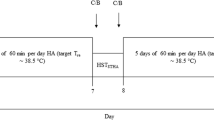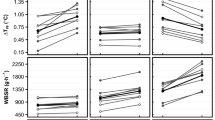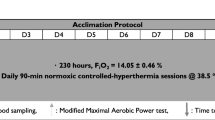Abstract
Compared with the induction of heat acclimation (HA), studies investigating the decay and re-induction of HA (RA) are relatively sparse and have yielded conflicting results. Therefore, 16 semi-nude men were acclimated to dry-heat by undertaking an exercise protocol in a hot chamber (dry-bulb temperature 46.1 ± 0.1°C; relative humidity 17.9 ± 0.1%) on 10 consecutive days (HA1–10) in winter UK. Thereafter, the subjects were divided into two groups and re-exposed to the work-in-heat tests after 12 and 26 days until RA was attained (RA12, n = 8; RA26, n = 8). The exercise protocol consisted of 60 min of treadmill walking (1.53 m s−1) at an incline individually set to induce a rectal temperature (T re) of ∼38.5°C during HA1 (equating to 45 ± 4% peak oxygen uptake), followed by 10 min of rest and 40 min of further treadmill exercise, the intensity of which was increased across HA to maintain T re at ∼38.5°C. T re, mean skin temperature, heart rate and rate of total water loss measured at 60 min did not change after HA7, and HA was taken as the mean of the responses during HA8–10. For both groups, there was no decay in T re and for all measured variables RA was attained after 2 and 4 days in RA12 and RA26, respectively. It is concluded that once adaptation to heat has been attained, the time that individuals may spend in cooler conditions before returning to a hot environment could be as long as one month, without the need for extensive re-adaptation to heat.







Similar content being viewed by others
References
Adam JM, Fox RH, Grimby G, Kidd DJ, Wolff HS (1960) Acclimatization to heat and its rate of decay in man. J Physiol 152:26–27
Armstrong LE, Maresh CM (1991) The induction and decay of heat acclimatisation in trained athletes. Sports Med 12:302–312
Borg GA (1982) Psychological basis of physical exertion. Med Sci Sports Exerc 14:377
Box GEP, Cox DR (1964) An analysis of transformations. J R Statist Soc B 26B:1–32
BSI (2001) BS EN ISO 10551. Ergonomics of the thermal environment—assessment of the influence of the thermal environment using subjective judgement scales. British Standards Institution. London, UK
Buono MJ, Heaney JH, Canine KM (1998) Acclimation to humid heat lowers resting core temperature. Am J Physiol 274:R1295–R1299
David HA (1970) Wiley series in probability and mathematical statistics. Order statistics in estimation and hypothesis testing, Chap. 6. Wiley, Oxford
Durnin JVGA, Womersley J (1974) Body fat assessed from total body density and its estimation from skinfold thickness: measurements on 481 men and women aged 16 to 72 years. Br J Nutr 32:77–97
Fox RH, Goldsmith R, Hampton IFG, Lewis HE (1964) The nature of the increase in sweating capacity produced by heat acclimatization. J Physiol (Lond) 171:368–376
Givoni B, Goldman RF (1973) Predicting effects of heat acclimatization on heart rate and rectal temperature. J Appl Physiol 35(6):875–879
Harrison MH, Saxton C (1976) Identification of an apprehension effect on physiological indices of thermal strain. Aviat Space Environ Med 47(9):950–953
Henschel A, Taylor HL, Keys A (1943) The persistence of heat acclimatization in man. Am J Physiol 140:321–325
Horowitz M (2003) Matching the heart to heat-induced circulatory load: heat-acclimatory responses. News Physiol Sci 18:215–221
Lind AR, Bass DE (1963) Optimal exposure time for development of acclimatization to heat. Fed Proc 22:704–708
Montain SJ, Maughan RJ, Sawka MN (1996) Heat acclimatization strategies for the 1996 summer olympics. Athl Ther Today, May:42–46
Nadel ER, Pandolf KB, Roberts MF, Stolwijk JAJ (1974) Mechanisms of thermal acclimation to exercise and heat. J Appl Physiol 37:515–520
Pandolf KB (1998) Time course of heat acclimation and its decay. Int J Sports Med 19:S157–S160
Pandolf KB, Burse RL, Goldman RF (1977) Role of physical fitness in heat acclimatization, decay and reinduction. Ergonomics 20:399–408
Ramanathan NL (1964) A new weighting system for mean surface temperature of the human body. J Appl Physiol 19:531–533
Roberts MF, Wenger CB, Stolwijk JAJ, Nadel ER (1977) Skin blood flow and sweating changes following exercise training and heat acclimation. J Appl Physiol 43(1):133–137
Robinson S, Turrell ES, Belding HS, Horvath SM (1943) Rapid acclimatization to work in hot climates. Am J Physiol 140:168–176
Saat M, Sirisinghe RG, Singh R, Tochihara Y (2005) Decay of heat acclimation during exercise in cold and exposure to cold environment. Eur J Appl Physiol. 95:313–320
Sawka MN, Wenger CB, Pandolf KB (1996) Thermoregulatory responses to acute exercise-heat stress and heat acclimation. In: Fregly MJ, Blatteis CM (eds) Handbook of physiology. Environmental physiology. Oxford University Press, New York, pp 157–186
Senay LC, Mitchell D, Wyndham CH (1976) Acclimatization in a hot, humid environment: body fluid adjustments. J Appl Physiol 40:786–796
Taylor NAS (2000) Principles and practices of heat adaptation. J Hum Environ Sys 4(1):11–22
Taylor NAS, Patterson MJ, Regan JM, Amos D (1997) Heat acclimation procedures: preparation for humid heat exposure. Technical Report, DSTO-TR-0580
Wenger CB (1988) Human heat acclimation. In: Pandolf KB, Sawka MN, Gonzalez RR (eds) Human performance physiology and environmental medicine at terrestrial extremes, Benchmark, Indianapolois, pp 153–197
Williams CG, Wyndham CH, Morrison JF (1967) Rate of loss of acclimatization in summer and winter. J App Physiol 4:383–395
Wyndham CH (1951) Effect of acclimatization on circulatory responses to high environmental temperatures. J Appl Physiol 22:27–30
Wyndham CH, Jacobs GE (1957) Loss of acclimatization after six days of work in cool conditions on the surface of a mine. J Appl Physiol 11:197–198
Acknowledgments
This work was funded by the Human Capability Domain of the UK Ministry of Defence Scientific Research Programme.
Author information
Authors and Affiliations
Corresponding author
Rights and permissions
About this article
Cite this article
Weller, A.S., Linnane, D.M., Jonkman, A.G. et al. Quantification of the decay and re-induction of heat acclimation in dry-heat following 12 and 26 days without exposure to heat stress. Eur J Appl Physiol 102, 57–66 (2007). https://doi.org/10.1007/s00421-007-0563-z
Accepted:
Published:
Issue Date:
DOI: https://doi.org/10.1007/s00421-007-0563-z




